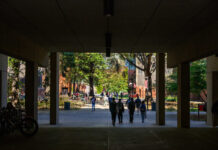As the days grow longer and warmer, many of us will begin to spend more time outdoors — planting flowers, attending Little League games, grilling out with neighbors, watching horses race and working on our tan.
Yet, excessive sun exposure without proper protection can bring an end to any fun in the sun.
Despite the fact that sun tanning and burning increases skin cancer risks, most Americans don’t protect themselves from the sun’s damaging rays. As a result, skin cancer is the most common malignancy, and the incidence of melanoma — the most serious form of skin cancer — is on the rise.
However, if detected early, skin cancer usually can be cured. For those at risk for skin cancer, early detection may lead to medical intervention and treatment at an earlier — possibly curable — stage of the cancer.
Skin Cancer Symptoms
Be alert to any kind of change in a mole. The four most common and most significant signs of change are a mole or skin area that:
- Changes in size
- Changes in color—typically gets darker
- Itches
- Bleeds
Whether or not you recognize that you have any of these symptoms, it’s important for you to understand the risk factors surrounding skin cancer.
Skin Cancer Risk Factors
All three types of skin cancer share common risk factors:
- Fair complexion and light hair
- A lot of moles
- Blistering sunburns
Many people who get melanoma will have had blistering sunburns in their teenage years. Sun exposure is the strongest risk factor and the one you can prevent by avoiding over-exposure to the sun.
Other ways to help prevent skin cancer:
- Use sunscreen and wear protective clothing
Studies have shown that using a sunscreen with SPF 30 or higher can prevent skin cancer. When you get up in the morning, put on your sunscreen. Put it on your face, hands and arms and those areas that are going to be exposed to the sun. Wear a hat and long sleeve shirt — those things that protect you from the sun rays if you’re going to be outdoors. Also, be sure to re-apply your sunscreen periodically if you stay outside for a while.
- Avoid the sun during peak hours
After 11 a.m., try to stay in the shade and out of the direct sunlight until 3 p.m. The sun is most intense at noon. Thus, the most damage is done at that time.
- Avoid tanning beds
Tanning beds, like the sun, expose you to ultraviolet radiation. So you keep adding more and more damage to your skin — just more quickly. In fact, the ultraviolet radiation exposure of a tanning bed may be riskier than exposure to the sun.
If left untreated, skin cancer can spread to other parts of the body. That is why routine screenings are so important. Coupled with a yearly skin exam by a doctor, it is important to perform self examinations of your skin every three months to detect the early warning signs of skin cancer.
The UofL Health Care Centers for Primary Care serve is a gateway to meeting all of your health care needs. You can reach us at the UofL Health Care Outpatient Center at 401 E. Chestnut St. (813-6800) and at Cardinal Station at the corner of Third Street and Central Avenue (852-5205).
(Editor’s Note: Health Today is a regular column from health care professionals at UofL that features information ranging from health issues to UofL faculty/staff benefits.)


























